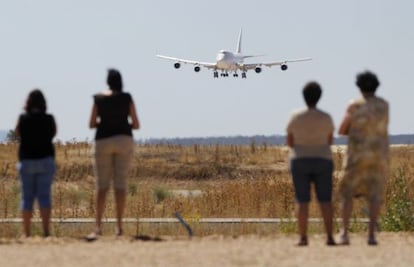Often overlooked, Spain’s Teruel finally takes off
A new airport in Aragon will be Europe’s largest aircraft repair and storage site, and could become a suborbital air base

Historically one of Spain’s more overlooked spots — Teruel is among the few provincial capitals without a high-speed rail link to Madrid, prompting a campaign under the slogan “Teruel exists” — the northeastern city has been chosen by French aeronautics company Tarmac Aerosave to house one of the world’s largest aircraft storage, maintenance and recycling sites at PLATA, Teruel Airport Platform.
The French company created a subsidiary, Tarmac Aragón, in 2011. With its new base at Teruel, Tarmac Aerosave is now the largest aircraft-storage company in Europe, with total storage capacity for 250 aircraft: 25 across the border in Tarbes and 225 in Teruel. Aircraft storage and maintenance accounts for 70 percent of the company's business. The remaining 30 percent of its activities involves the recycling of parts and engines.
Teruel will be competing directly with the United States, challenging its traditional dominance in the MRO-maintenance, repair and overhaul sector. Until now, European companies had to fly their aircraft across the Atlantic and out to sites usually located in the south west of the country.
The airport has a 2,825-meter runway that can handle suborbital aircraft, which can fly up to 90 miles into the stratosphere. The airport's director, Alejandro Ibrahim, says that Teruel has been talking to a number of companies offering suborbital trips, such as Space Adventures, Virgin Galactic, Space Expedition Corporation, Blue Origin, Armadillo Aerospace, Rocket Plane Limited, XCOR Aerospace, Astrium, and Dassault. "Virgin Galactic plans to provide suborbital spaceflights to space tourists, suborbital launches for space science missions and orbital launches of small satellites. They already have offices in New Mexico, and they want to set one up in Europe. We want to be that place," he says.
Short suborbital trips are set to become the tourism of the future"
The airport is also on a shortlist of 10 candidates as a European base for space travel by France's Aeronautical University's Grand Earth team.
Teruel is the highest-altitude airport in Spain and has a very low volume of air traffic, two other features that are essential for this purpose.
"Short suborbital trips are set to become the tourism of the future and many European and US-based companies are also already researching the possibility of air-travel via space to cut down journey times of long-haul flights," says Ibrahim.
The idea for PLATA dates back more than a decade, when local company López Soriano, which wanted to build a recycling plant in Zaragoza, approached the regional government. Eventually, the administration developed the idea of an MRO, deciding on Teruel, in part because the area is sparsely populated and enjoys around 250 days of sunshine a year. Work began in 2009, and was completed at the beginning of 2013.
Occupying a site of around 340 hectares, around a third of the size of Barajas Airport in Madrid, PLATA will not handle passenger traffic, sparing it the fate of ghost airports such as Castellón or Ciudad Real, something the regional government is keen to point out. "It has cost a little over the 40-million-euro budget," says Rafael Fernández de Alarcón, the head of public works at the regional government of Aragón.
Last Thursday, the first of what PLATA says will be around 200 aircraft to use the site over the coming years, a Boeing 747, touched down. Local people gathered outside the airport to watch the historic event. "We've been disappointed in the past when plans for projects never came to fruition. We're hoping that this will generate jobs for the area, as promised. People were initially skeptical, but there is a sense of hope now," said a local resident.
We're hoping that this will generate jobs for the area, as promised"
Tarmac Aragón has been granted use of the airport until 2038, and its French parent company, in which Airbus has a stake, will pay 1.25 million euros a year to the regional government over the next 25 years. The company will also cover the 4.2-million-euro cost of paving the site.
José Moliner, the company's commercial director, says that Tarmac Aragón was set up when the parent company's president, Philippe Fournadet, visited the site and saw its potential. "When the boss saw this for the first time, he couldn't believe it. He was amazed that a site like this, which is only five hours' drive away from our base in Tarbes, could exist. It's perfect for us."
Claude Zambrano, the head of Tarmac Aragón says that the project should create around 100 direct jobs over the next six years, and that the tax imposed on the company will cover the annual maintenance costs of around 600,000 euros. Other revenue will be created from landing taxes and a range of services.
Simón Casas, the former head of the regional government of Aragon’s transport department, says that when the project was initially mooted, few believed it would get off the ground. “They used to say that Teruel didn’t exist... Well, it not only exists, but we’re now building an astrophysics laboratory to see if we can do more with this.”
Tu suscripción se está usando en otro dispositivo
¿Quieres añadir otro usuario a tu suscripción?
Si continúas leyendo en este dispositivo, no se podrá leer en el otro.
FlechaTu suscripción se está usando en otro dispositivo y solo puedes acceder a EL PAÍS desde un dispositivo a la vez.
Si quieres compartir tu cuenta, cambia tu suscripción a la modalidad Premium, así podrás añadir otro usuario. Cada uno accederá con su propia cuenta de email, lo que os permitirá personalizar vuestra experiencia en EL PAÍS.
¿Tienes una suscripción de empresa? Accede aquí para contratar más cuentas.
En el caso de no saber quién está usando tu cuenta, te recomendamos cambiar tu contraseña aquí.
Si decides continuar compartiendo tu cuenta, este mensaje se mostrará en tu dispositivo y en el de la otra persona que está usando tu cuenta de forma indefinida, afectando a tu experiencia de lectura. Puedes consultar aquí los términos y condiciones de la suscripción digital.
Últimas noticias
The complicated life of Francesca Albanese: A rising figure in Italy but barred from every bank by Trump’s sanctions
Half of Scotland is in the hands of 420 property owners
Pinochet’s victims grapple with José Antonio Kast’s rise in Chile
Reinhard Genzel, Nobel laureate in physics: ‘One-minute videos will never give you the truth’
Most viewed
- Pablo Escobar’s hippos: A serious environmental problem, 40 years on
- Why we lost the habit of sleeping in two segments and how that changed our sense of time
- Charles Dubouloz, mountaineering star, retires at 36 with a farewell tour inspired by Walter Bonatti
- Reinhard Genzel, Nobel laureate in physics: ‘One-minute videos will never give you the truth’
- The Florida Keys tourist paradise is besieged by immigration agents: ‘We’ve never seen anything like this’









































